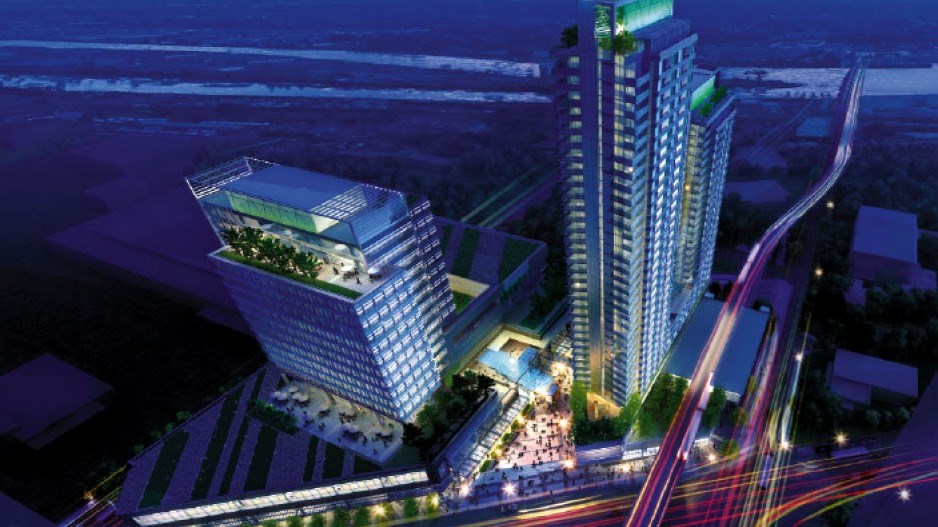No questions
Premier Christy Clark didn’t take questions when she addressed the Urban Development Institute (UDI) last week. She fielded a dozen questions at a press conference in the morning, and according to press secretary Sara MacIntyre she was saving her wit for an afternoon event.
There was no question that she was among friends, however, as UDI president Don Forsgren thanked her for transitional rules during the HST phase-out that “went well beyond our expectations.”
UDI director Ward McAllister then welcomed “my friend Christy” as “the leader of our party,” gushing: “We love you to pieces, and we’re going to be all there for you.”
Clark thanked McAllister with a peck on the cheek and took the podium to rouse support for “B.C.’s free enterprise team.”
But where the applause fell spoke volumes. Clark garnered handclaps when she stepped up to the microphone, and a standing ovation when she finished speaking. Titters followed her remark that her son wanted BC NDP leader Adrian Dix to take him to hockey practice – Clark’s son Hamish being set on a new pair of skates, which she can’t afford, he doesn’t need and won’t be bought simply to keep him quiet. (Dix is a softer touch, apparently.)
But the loudest, most spontaneous round of applause from the crowd of developers came when Clark praised Coquitlam Mayor Richard Stewart for helping quell the infighting among mayors that dogged an agreement regarding the Evergreen Line. Clark might have billed the Port Mann Bridge as a project that would open development opportunities for her audience, but transit lines seemed of greater interest than roadways.
Wasteland, adieu!
T.S. Eliot and Dante Alighieri rarely get mentioned at breakfast meetings of commercial real estate association NAIOP. During the association’s recent breakfast meeting, PCI Group’s Marine Gateway project at Cambie and Southwest Marine Drive was touted as a place where connections happen – unlike Dante’s vision of hell, which Eliot described as “a place where nothing connects with nothing.”
Marine Gateway might not be paradise, but it’s a step closer than the bunker-like ICBC claims centre that formerly occupied the site. ICBC’s building wasn’t on a rapid transit line nor was it particularly high-density. It hosted just 60 jobs versus the 2,000 in office, retail and service positions that PCI expects when Marine Gateway completes.
“This was an area where the densest development outside of Oakridge was going to happen,” said Dan Turner, senior vice-president of PCI. “So we knew retail was going to work.”
A grocery store – a 46,500-square-foot T&T Supermarket – was the ideal anchor, because it would serve both residents and office workers as well as be a draw for additional tenants.
Turner said large-format retail wouldn’t have made sense in the emerging location, with its mix of residential, office and transit-oriented uses.
“We wanted a 24/7-type property,” he said. “There’s going to be 18 hours where it will be a very vibrant community. … There’s very little down time.”
Sure, the site will continue to border an industrial area, complete with the scent of milled wood, but it’s a step above the sulphuric scent of brimstone reputed to perfume the netherworld. The property seemed a good bet even before the Canada Line was built, and Tracie McTavish, president of Rennie Marketing Systems, said a record 11,000 registrants were logged for the 415 residential units available in just four months – quadruple the usual volume. The project sold out in one day.
“I think this is setting the stage for the Cambie corridor,” McTavish said.
Density key
To the north on Cambie, plans for the redevelopment of Oakridge Centre seem to hang on transit.
There’s been no change to the existing vision for the site, endorsed by Vancouver councillors in 2007, but Ivanhoe Cambridge’s engagement of Henriquez Partners Architects to oversee the site’s redevelopment promises some tweaking.
A March 29 open house sought feedback from area residents regarding plans for the site, which sits on a transit line but remains more akin to a suburban shopping mall (with sprawling parking lots out back to boot). While adding density to the site has long been planned to complement the transit line, architect Gregory Henriquez believes more can be done to develop a neighbourhood whose population was growing prior to the 2011 census, when it shed approximately 300 residents. Detached homes predominate, at prices beyond what younger families can afford. Seniors are growing in number, and residents of the area support changes responsive to its shifting demographics.
While planning is in the early stages, what happens at Oakridge may well point a way forward for the redevelopment of single-family neighbourhoods elsewhere in Vancouver where an aging population and affordability stand to be key questions in the years ahead. •




